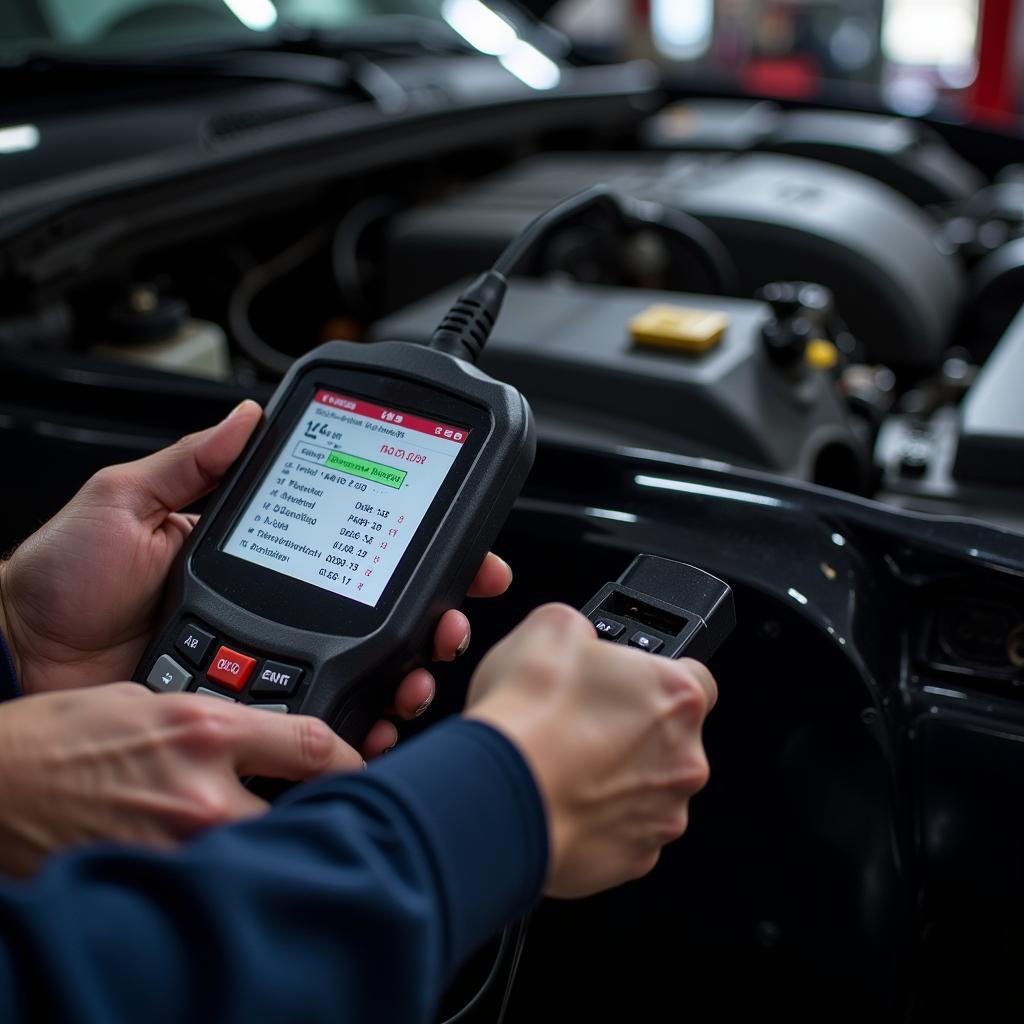Car on-board diagnostics, or OBD, refers to a vehicle’s self-diagnostic and reporting capability. It involves a standardized system that monitors emissions, engine performance, and other critical components in real-time. When the OBD system detects a problem, it generates a diagnostic trouble code (DTC), which is essentially a code that corresponds to the specific issue.
 Car Dashboard Warning Lights
Car Dashboard Warning Lights
How Car On-Board Diagnostics Work
At the heart of the OBD system is the Electronic Control Unit (ECU), often called the “car’s brain.” This unit continuously monitors various sensors located throughout your vehicle. These sensors measure parameters like engine speed, temperature, oxygen levels, and more.
When a sensor detects a reading outside the predefined acceptable range, the ECU interprets it as a potential problem and logs a DTC. This triggers the “Check Engine” light on your dashboard, alerting you to the issue.
The Evolution of On-Board Diagnostics: OBD-II and Beyond
While the concept of on-board diagnostics has been around since the 1980s, it wasn’t until the introduction of OBD-II in 1996 that it became a standardized system across all vehicles sold in the United States. This standardization revolutionized car repair by:
- Providing a uniform method for accessing diagnostic information: Mechanics could now use a single type of connector and software to diagnose issues across various makes and models.
- Empowering car owners: OBD-II made it possible for car owners to access basic diagnostic information and potentially troubleshoot minor problems themselves.
Today, OBD-II remains the standard for light-duty vehicles. However, newer vehicles are incorporating more advanced diagnostics and even wireless communication capabilities, allowing for remote diagnostics and software updates.
Benefits of Using Car On-Board Diagnostics
The advantages of car on-board diagnostics extend to car owners, mechanics, and even the environment:
- Faster and More Accurate Diagnoses: OBD-II significantly reduces the time and effort required to pinpoint the root cause of car problems, leading to faster repairs.
- Lower Repair Costs: By identifying specific issues, OBD-II helps avoid unnecessary repairs and replacements, saving you money in the long run.
- Improved Fuel Efficiency: Detecting and addressing engine performance issues can improve fuel economy and reduce emissions.
- Preventive Maintenance: Regular monitoring of your car’s systems through OBD-II allows for early detection of potential problems, preventing costly breakdowns.
does my car have an onboard diagnostics
Understanding Diagnostic Trouble Codes (DTCs)
DTCs are the language of your car’s OBD system. These alphanumeric codes, typically a five-digit combination of letters and numbers, provide a standardized way to identify specific problems. For instance, a code like “P0301” indicates a misfire in cylinder 1.
While there are thousands of potential DTCs, they follow a general format:
- First Character: Indicates the system related to the code (e.g., “P” for Powertrain, “B” for Body, “C” for Chassis, “U” for Network communication).
- Second Character: Can be “0” for a standardized (SAE) code or “1” for a manufacturer-specific code.
- Third Character: Specifies the subsystem related to the code (e.g., “3” for Ignition System, “4” for Auxiliary Emissions Controls).
- Fourth and Fifth Characters: Pinpoint the specific problem within the subsystem (e.g., “01” in “P0301” indicates cylinder 1).
 Mechanic Using OBD Scanner
Mechanic Using OBD Scanner
Using OBD-II Scanners: DIY vs. Professional
While accessing basic OBD-II information is possible with affordable code readers, professional-grade OBD-II scanners offer more advanced features:
- Reading and Clearing DTCs: Both basic and professional scanners can read and clear DTCs.
- Live Data Stream: Professional scanners can display real-time data from various sensors, allowing for more in-depth analysis.
- Bi-Directional Control: Some professional scanners enable bi-directional control, meaning they can send commands to specific components for testing purposes.
- Advanced Programming: Certain professional-grade tools allow for advanced programming and coding of vehicle modules.
Expert Insight:
“While basic OBD-II scanners can be helpful for DIY enthusiasts, it’s important to remember that professional-grade tools offer a much deeper level of functionality and are essential for complex diagnostics and repairs,” says John Miller, a certified master automotive technician with over 20 years of experience.
The Future of Car On-Board Diagnostics
[on board diagnostics car](https://diagfixpro.com/on-board diagnostics-car/)
The landscape of car on-board diagnostics is continuously evolving. Trends shaping the future include:
- Telematics and Remote Diagnostics: Cars are becoming increasingly connected, enabling remote diagnostics and even predictive maintenance.
- Over-the-Air (OTA) Updates: OBD systems and vehicle software can now be updated wirelessly, improving functionality and addressing issues without a trip to the dealership.
- Integration with Advanced Driver-Assistance Systems (ADAS): OBD data is being used to enhance the capabilities of ADAS features like lane keeping assist and adaptive cruise control.
Conclusion
Car on-board diagnostics, particularly OBD-II, have revolutionized the way we diagnose and repair vehicles. Understanding the basics of OBD-II can empower you to be a more informed car owner, enabling you to make better decisions about maintenance and repairs. As vehicles become increasingly complex, staying informed about the evolving world of on-board diagnostics will be more critical than ever.

Leave a Reply